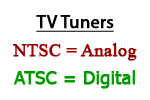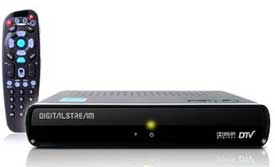
|
|
 |

|


 What in the HD World? What in the HD World?Countdown to the Switch to DTV
 Dick De Jong
Dick De JongMarch 31, 2008 HDTV Solutions On February 17, 2009, Congress has mandated that television stations in the U.S. must stop transmitting analog TV signals and switch to digital. (Editor's update: Congress has passed a bill extending the deadline to June 12, 2009 and President Obama has signed the bill into law. But about 36% of the stations in the U.S. decided to make the switch to digital on the original February 17 date. You can read more about the extension here, DTV Transition Extended.) What impact will this "switch" to DTV have on you? Let's take a look at what this transition is and how it could affect a typical household. Probably the most important thing to know about this switch is that it concerns over-the-air (OTA) broadcasts. We're talking about the TV signal you receive from your local television stations through an antenna. Basically, if your TVs are hooked up to a cable or satellite system, you won't be effected, even if you own an old TV. But if any of your TVs are receiving OTA signals - yes, even that ancient 19" TV in the guest room - then you should pay attention. And for those who are already digitally connected, you may want to stick around because any day now you might be getting a call from your grandmother who is worried that she won't be able to watch the local evening newscast. Also, if you still record your favorite programs on a VCR, I have advice for you too. And finally, people are becoming confused about what this transition means in terms of programming. I'll try to clear up the difference between DTV and HDTV. Converter Boxes
Since the 1950's, local TV stations have been broadcasting their signals from their big antenna to your TV's antenna through a modulated system that we now designate as analog. All TVs back then had a tuner that received the analog signal and displayed it on your set. Even today, every TV, even HDTVs have an analog, NTSC, tuner. Analog transmission never was the greatest and in the last few years, digital broadcasting has become popular because it is cleaner, clearer and more efficient. Congress and the FCC (Federal Communications Commission) have been planning to make the switch to digital for years. And in fact, over two thirds of the local TV stations around the country are already transmitting digital OTA signals along with separate analog signals. 
On February 17, all full power TV stations will stop broadcasting analog signals and switch exclusively to digital transmission. Now the problem is that your TV needs a digital, ATSC, tuner to receive the digital signal. In anticipation of the switch, the FCC mandated three dates in which all TVs entering the U.S. must have ATSC tuners. On July 1, 2005, all televisions with screen sizes over 36" needed ATSC tuners. On March 1, 2006, it included TVs 25" or larger. And on March 1 of 2007, all TVs must have an ATSC tuner. If you buy a new TV today, it should have an ATSC tuner. Though I caution you that there is a slight chance that some outdated models without ATSC tuners are still being sold. Be sure to verify that the TV is properly equipped. 
Of course, most TVs made before 2000 did not have an ATSC tuner. If your TV doesn't have one and you are relying on OTA analog signals, then you will need to buy a converter box for that TV. Basically the converter box will take that fancy new digital signal from your local television stations and convert it back to analog so that your old TV can see it. If you think about it, the converter box is turning back the clock. It is not making your old analog TV magically digital. 
Realizing that many people will be adversely affected by the switch, Congress set up a converter box coupon program to ease the transition. The NTIA (National Telecommunications and Information Agency) has begun giving up to two $40 coupons to households to defray the expense of digital to analog converter boxes, which usually cost about $40 to $70 a piece. (You cannot combine two coupons to buy one box.) These coupons do not automatically appear in your mailbox. You need to request them. You can apply for coupons online at dtv2009.gov or call 1-888-DTV-2009. After you receive the coupons, you need to buy the boxes. Most major retailers like WalMart, Best Buy and Radio Shack have them in stock. You can also order them online from a variety of sources. To recap, if you are receiving over-the-air programming and your old TV does not have a digital, ATSC tuner, then it will not be able to tune into your local stations after February 17, 2009. To keep watching TV, you have three options:

I Bought the Box, Now What?
You will still need an antenna. Let me say this again, the converter box does not replace your antenna, which is capturing the TV signal out of the air. Theoretically, if your indoor or rooftop antenna was providing good reception of your analog channels, then it should continue to do the job with the digital signals - even better in some cases. Of course, there will be plenty of instances of people not having good reception with the combination of their old antenna and the new converter box. My suggestion is try your old antenna, if it works, you're set. If not, then take the opportunity to try a new antenna. You may find that the quality of your picture may improve and that you receive stations that you couldn't pull in before. Now, you have your antenna connected to your converter box which is attached to your TV. Are you ready for your next surprise? Even though it is called a converter box, remember that it is also an ATSC tuner and it is replacing the tuner in your TV. Simply, you will be changing channels on your converter box and not on your TV. When you first setup your converter box, you will have it scan for all of the available channels. You then set your TV to channel 3 or 4 and leave it. You will use the converter box's remote control to change channels. I can imagine that you will be grabbing your TV remote to channel surf, to no avail. It's a habit that you will have to break. When you are shopping for converter boxes, you may wish to check out how robust the remote is. If your TV has Picture-in-Picture (PIP) capability, it is one of the casualties of this new system. PIP relies on your TV's internal tuners that are no longer functional. If you are a PIP fan, you can begin to understand why people seriously consider buying a new digital TV or subscribing to a cable or satellite provider. Another victim of the switch is the old VCR because it only has an analog NTSC tuner in it. If you still plan to record TV with your VCR, you can connect the converter box to it and then to the TV. The one drawback to this configuration is that you can no longer program the VCR to record multiple shows on different stations. For example, the only way to record Ugly Betty at 7 p.m. on ABC and then tape CSI at 8 p.m. on CBS is to be standing next to the converter box at 8 to switch it to the right channel. If not, you are out of luck because the VCR cannot tell the converter box to change channels.  RCA DVD Recorder/VCR with Digital ATSC Tuner If you are an unwavering VCR diehard, I am finding a few DVD/VCR combo products that do include an ATSC tuner. Though a bit pricey, they do offer you programmable recording and you wouldn't need a separate converter box. DTV Does Not Mean HDTV
Now, there is one big misconception that I want to caution you about. If you read the news reports or publications about this switch, you will see the term DTV being bandied about. DTV stands for digital television, which, depending on who you are talking to, can mean a lot of different things. In the context of the transition from analog to digital, DTV is used to describe the new digital OTA broadcast system. In this use of DTV, we are talking about signals and not television sets or high definition. I received an email that was complaining about how much cable systems were charging for high definition programming and he said, "They're ripping us off before the mandate to go all HD." As you can see, the FCC has not mandated a transition to high definition. The law only deals with a change to digital transmission and only then for OTA local channels. This switch will not marvelously morph our old SD TVs into HDTVs. And it is not going to amazingly change all the standard definition programming into high definition. (The difference between standard and high definition is a matter of picture resolution. Both SD and HD programs can be transmitted digitally.) By February 17, 2009, more and more programs will be created and broadcast in HD. In fact, many stations are beginning to shoot their local evening news in HD. And spurred by this deadline, the purchases of HDTVs are outnumbering standard definition TVs. The specter of this Congressional decision has definitely nudged the progression to HD, but it did not specifically mandate it. The transition from analog to digital does not directly effect any of the cable networks like ESPN or TNT or HBO. If you think that cable companies are charging too much for their HD tier, this transition will not solve that problem. Remember we are talking about local television stations, which depending on where you live means channels that carry the networks like ABC, CBS, CW, Fox, NBC, PBS, and Univision. These are considered full power television stations, which brings up one final point that may be important to you. Many communities have what are labeled low power TV stations. Some of them only broadcast in a radius of a few miles. Often they are religious or foreign language stations. Where I live, I can receive about three or four of them. These low power channels do not have to migrate to digital transmission. Of course, if your TV is hooked up to a converter box, you won't be able to tune in these analog channels unless the box has some sort of pass through system for analog signals. If you watch these low power stations often, then you will need to figure out a system to tune them in. One thought is not to connect one of your TVs up to a converter box and reserve it for these analog stations. And if you only have one TV, goodness knows that you should be able to pick up an old analog set at Goodwill for almost nothing. I know all this may be a lot to consume, but a wide range of organizations like AARP are providing information and consultation on the transition. And we plan on keeping you up to date on any new changes. Of course, feel free to email me if you have questions. Stay tuned. |
Bookmark:
![]() del.icio.us
del.icio.us
![]() Reddit
Reddit
![]() Google
Google
| Send this Page | Print this Page | Report Errors |

